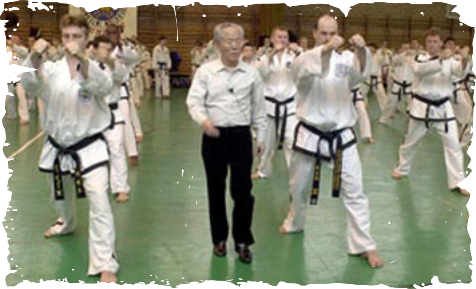Pattern Histories
An introduction to our Patterns or Tul
Forms, or tul (also teul or 틀) in Korean, originally called hyeong, form an important aspect of training in Taekwon-Do. They are equivalent to the kata in karate. The majority of the patterns (except Yul-Gok, Ul-Ji and Tong-Il) start with a defensive move, which emphasizes taekwon-do's defensive nature. All of the patterns start and end at the same location. This ensures that the practitioners' stances are the correct length, width, and in the proper direction. There are 24 patterns in the official ITF "Chang Hon" syllabus as created by our Founder - General Choi Hong Hi; this is symbolic of the 24 hours in a day. One additional pattern, Ko-Dang (or Go-Dang), was retired/replaced by Juche in 1986 by General Choi. Ko-Dang and Juche are similar, and some Taekwon-do organisations have renamed Juche to Ko-Dang though most perform the newer pattern. The names of these patterns typically refer either to events in Korean history or to important people in Korean history. Elements of the patterns may also be historical references, such as the number of moves, the diagram or the way the pattern ends. Below are links to detailed history pages for each of our patterns as created by General Choi Hong Hi.
Forms, or tul (also teul or 틀) in Korean, originally called hyeong, form an important aspect of training in Taekwon-Do. They are equivalent to the kata in karate. The majority of the patterns (except Yul-Gok, Ul-Ji and Tong-Il) start with a defensive move, which emphasizes taekwon-do's defensive nature. All of the patterns start and end at the same location. This ensures that the practitioners' stances are the correct length, width, and in the proper direction. There are 24 patterns in the official ITF "Chang Hon" syllabus as created by our Founder - General Choi Hong Hi; this is symbolic of the 24 hours in a day. One additional pattern, Ko-Dang (or Go-Dang), was retired/replaced by Juche in 1986 by General Choi. Ko-Dang and Juche are similar, and some Taekwon-do organisations have renamed Juche to Ko-Dang though most perform the newer pattern. The names of these patterns typically refer either to events in Korean history or to important people in Korean history. Elements of the patterns may also be historical references, such as the number of moves, the diagram or the way the pattern ends. Below are links to detailed history pages for each of our patterns as created by General Choi Hong Hi.




